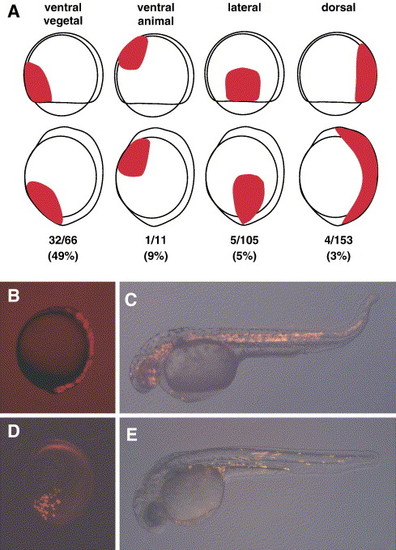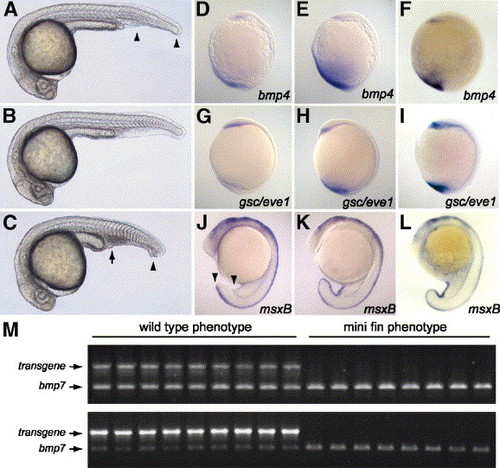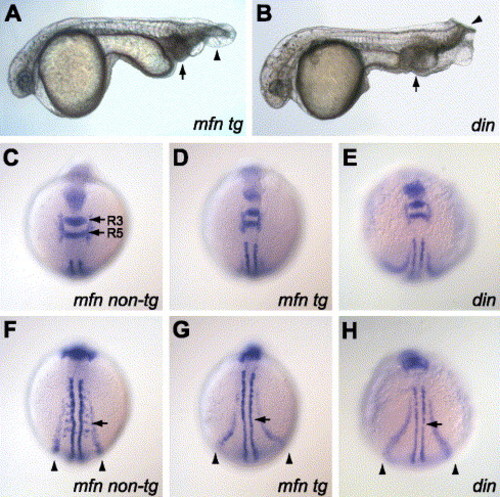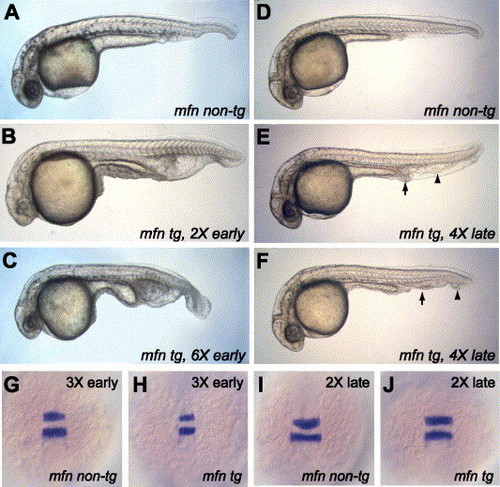- Title
-
Temporal and spatial action of Tolloid (Mini fin) and Chordin to pattern tail tissues
- Authors
- Connors, S.A., Tucker, J.A., and Mullins, M.C.
- Source
- Full text @ Dev. Biol.
|
Tolloid activity is required in ventral-vegetal cells. (A) Schematic of cell transplantations (location of wild type cells in red) in gastrula or bud stage embryos, N values and percent of rescue observed. The dorsal group also includes dorsolateral clones (0/32 rescued). Not included are 7/30 (23%) cases of rescue seen in transplants that were scored as ventrolateral at the margin. (B) Fluorescence image of an embryo at bud stage with cells located dorsally and (C) the same embryo at 24 hpf displaying the mfn phenotype, indicating no rescue. (D) Fluorescence image of an embryo at bud stage with transplanted cells located ventrally, and (E) the same embryo at 24 hpf shows rescue of the mfn phenotype. (C, E) Fluorescence images are overlaid on the bright field image to show the location of transplanted cells at 24 hpf. All are lateral views except (D), which is slightly ventral-lateral. (A, B, D) Dorsal is to the right and anterior is up. (C, E) Anterior to the left. |
|
An hsp-tolloid transgene rescues the mini fin phenotype. All embryos were heat-shocked for 10 min at 37°C during late gastrulation. (A–C) Heat-shocked embryos at 1 dpf. Non-transgenic mfn embryos (A) still display the mfn phenotype (arrowheads indicate missing fin), but transgenic mfn embryos are rescued to a phenotype indistinguishable from wild type (B) or are ventralized (C), as demonstrated by excess blood (arrow) and duplicated tail fins (arrowhead). Heat-shock-treated mfn transgenic (E, H, K) and non-transgenic sibling (D, G, J) and wild type (F, I, L) embryos. (D–F) bmp4 expression at bud stage. (G–I) eve1 and goosecoid (gsc, as a control) expression at the 1-somite stage (N = 18). (J–L) msxB expression at the 20-somite stage (N = 18). Arrowheads indicate absent msxB expression domain in mfn (J), which is restored in the transgenic mutant (K). (D–L) Lateral views, dorsal to the right, anterior to the top. (M) Duplex PCR for Tg(hsp70:tld) and bmp7. All rescued wild type or ventralized embryos carry a copy of the Tg(hsp70:tld) and endogenous bmp7 (control), whereas non-rescued mutants carry only the bmp7 gene. PCR from two different transgenic lines are shown (top, line 30; bottom, line 1). EXPRESSION / LABELING:
|
|
Temporal rescue of mini fin mutants by hsp-tld. (A–C) tld and (D–F) eve1 expression in transgenic mfn mutant embryos heat-shocked for 10 min during late gastrulation (85–90% epiboly). Expression of tld (N = 30) and eve1 (N = 15) in embryos fixed before the heat-shock treatment (A, D). Expression of tld 10 (N = 33) (B) or 30 (N = 43) (C) min after the start of the heat-shock. Expression of eve1 1 h after the start of the heat-shock in non-transgenic (E) and transgenic embryos (N = 15) (F). (G) Expression of myc-tagged Tld protein after a 10-min heat-shock, or in the last lane a 60-min heat-shock, during late gastrulation. Embryos were collected at stated time points following the start of the heat-shock period and assayed by anti-myc Western blot analysis. A lower non-specific cross-reacting band serves as a loading control. (H) Graphic representation of rescue of mfn transgenic embryos after a 10-min heat-shock treatment at different time points during development. The blue graph indicates an average of the percent rescue seen in multiple transgenic lines heat-shocked. The red graph shows a “sub-optimal” 7-min heat-shock performed in transgenic line 75, so that less than 100% of the transgenic embryos at any time point were rescued. EXPRESSION / LABELING:
|
|
Overexpression of tolloid phenocopies the chordino mutant. A Tg(hsp70:tld) embryo heat-shocked during and after gastrulation to remove Chd activity (A) can phenocopy din/chd mutants (B). Eye and head size is reduced, the blood increased (arrow), and the tail fins duplicated (arrowhead). Dorsal-anterior views of a representative 7-somite stage non-transgenic mfn embryo (N = 37) (C), transgenic mfn embryo (N = 42) (D), or din homozygote (E) stained for myoD, krox20, gata1, and pax2.1. R3 and R5 refer to rhombomeres 3 and 5, respectively. (F–H) More posterior dorsal views of embryos shown in panels (C–E). Arrows indicate smaller somites, and arrowheads indicate more laterally located pronephric and blood precursor domains in transgenic and din mutants. EXPRESSION / LABELING:
|
|
Chordin activity is required during gastrulation and segmentation stages. (A) Non-transgenic mfn and (B) Tg(hsp70:tld); mfn embryo heat-shocked twice for 1 h, at high stage (∼3.5 hpf) and then early gastrula stage (∼6.5 hpf) (2× early). (C) Representative Tg(hsp70:tld); mfn embryo heat-shocked for 6 rounds from pregastrulation to the 18-somite stage (6× early, N = 10). Note the stronger ventralization in the embryo lacking Chd activity during both gastrulation and somitogenesis (C). Non-transgenic (D) and Tg(hsp70:tld) (E–F) mfn embryos heat-shocked 4 times between the bud and 18-somite stages. A weak ventralized phenotype is observed as excess blood (arrow), blistering of the ventral tail fin (arrowhead in panel E), and small duplications of the ventral tail fin (arrowhead in panel F). krox20 expression in non-transgenic (G) and transgenic (H) mfn embryos heat-shocked 3 times prior to and during gastrulation (N = 22). krox20 expression in non-transgenic (I) and transgenic (J) mfn embryos (N = 20) at the 9-somite stage that were heat-shocked twice after gastrulation (2× late). A 2× rather than 4× heat-shock was performed so that krox20 expression could be examined at the 9-somite stage. Note a reduction in krox20 expression only when Chd is inhibited during gastrulation. EXPRESSION / LABELING:
|
Reprinted from Developmental Biology, 293(1), Connors, S.A., Tucker, J.A., and Mullins, M.C., Temporal and spatial action of Tolloid (Mini fin) and Chordin to pattern tail tissues, 191-202, Copyright (2006) with permission from Elsevier. Full text @ Dev. Biol.





